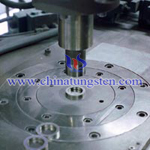Manufacturing Process of Tungsten Copper
Most refractory metal are produced by means of powder metallurgy. High conductivity metals such as silver or copper are blended with metals that demonstrate the ability to withstand severe electrical and mechanical forces. Depending on the required composition, one of three processes is generally employed. Press-Sinter-Infiltrate (PSI) generally provides the highest density material, while the Press-Sinter-Repress (PSR) process is required for certain compositions. In some cases, a Press-Sinter (PS) only process is appropriate.
 Powders and Mixing:
Powders and Mixing:
Regardless of the process, the initial production step involves the blending of powders, along with additives. Prior to mixing, all powders are certified for purity and reviewed for correct particle size and distribution, apparent density, and flow characteristics. Once certified and released to production, powders are mixed based on engineering specifications for a given material composition.
Pressing:
Compaction presses ranging from 14 to 250 tons are used to produce basic contact geometries. Pre-mixed powders are fed into a die cavity, then upper and lower punches combine to create the contact face and back detail. The "green" compacted part weight, thickness, and density are closely monitored using SPC techniques. These part properties are critical to final composition and dimensional control.
Sintering:
When processing refractory compositions, in addition to driving off binders and lubricants, sintering in a high temperature furnace allows the creation of metallurgical bonds between the powder particles and the creation of a "refractory skeleton" that can be infiltrated or repressed. Typically, after sintering, contacts are at the final dimensional requirement, eliminating the need for expensive machining. Furnace atmosphere as well as time and temperature are closely controlled throughout this process.
Infiltration/Repressing:
In the production of refractory based electrical contacts, infiltration or repressing is required, depending on the desired material composition. During the infiltration process, the sintered contact is fed through a furnace with a carefully controlled pre-cut slug of pure copper or silver. This slug of copper or silver is placed on the "serrated" side of the contact and, under time, temperature, and atmospheric control, infiltrates the previously formed contact "skeleton".
A repressing or coining operation is used to attain final density for other types of materials such as silver graphite, silver tungsten-carbide graphite, or copper graphite.
Any feedback or inquiry of Tungsten Copper Alloy Products please feel free to contact us:
Email: sales@chinatungsten.com
Tel.: +86 592 512 9696 ; +86 592 512 9595
